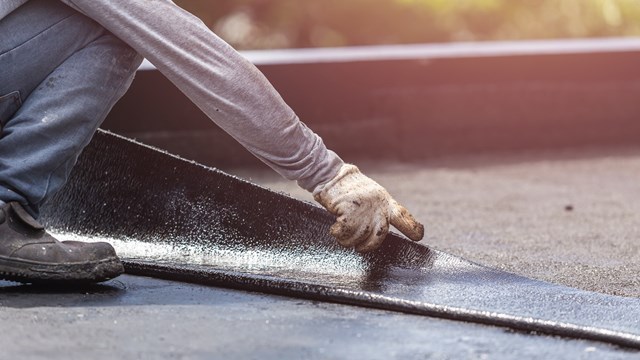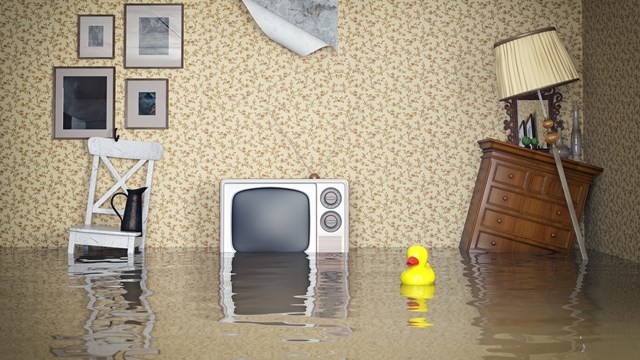
Edgar Dworsky is the treasurer of a small condo complex in Somerville, Massachusetts that was built back in 1987. He loves where he lives except for one rather large problem. Water leaks have plagued the complex since it was built. During driving rains, water comes in from around the windows and near the chimney. The association has tried numerous solutions to fix the problem, but nothing has worked very well.
“Water problems are completely frustrating and expensive to try to fix,” says Dworsky.
Water leaks are one of the most damaging things that can happen to a condo, whether in the units or on the common property—especially if, like Dworsky’s complex, they are stealthy leaks that are hard to detect. Among other things, the leaks can be caused from a poorly-constructed building, old pipes, poorly-maintained valves, and damage caused by other factors such as storms. “Everybody that we’ve had in here has told us where they think it’s coming from, and every person has been different, but nobody has been right,” says Dworsky.
Water, Water, Wherefore Art Thou?
Although Dworsky’s building problems seems to have started at the construction phase, Russell Fernandes, principal and vice president of Becht Engineering, BT, Inc in Liberty Corner, New Jersey, says that roofs and siding or façade leaks can develop at any time in a building’s life span.
“Pipes begin to deteriorate in the 20- to 30-year range of a building’s life,” says Fernandes. “This is particularly troublesome in high-rise buildings with large riser pipes—the pipes that run from basement to top floor, inside walls—to supply everything from hot and cold domestic water to air conditioning and heating.”
Fernandes explains that there are three main causes for water leaks in buildings—a water leak in the building envelope, which is the roof, walls and windows; a foundation leak from ground water; or a leak from a plumbing system, whether it’s fresh water or sanitary sewer drain lines.
Water leaking around a window is usually coming from the flashing and/or intersection with the exterior siding system. Flashing is the thin layer of waterproof material that keeps water from getting into the building at the joints between perpendicular surfaces.
“Downspouts that are not functioning properly can also result in foundation leaks into basements and crawl spaces,” Fernandes continues. “Roof water should be directed as far away from the foundation as possible. Downspouts should either discharge on splash blocks to direct roof water away from a building’s foundation or even better, into an underground drainage system connected to the municipal storm water system.”
Of course, the most obvious sign of a leak is visible water, but there may be other indications, according to Barry Grummer of Kay Waterproofing Corporation in Manhattain. “Above ground, you'll see peeling and blistering paint, or staining inside an apartment," he says. "There are underground leaks where you actually see water coming in through the foundation of walls, and sometimes you'll see efflorescence, or a white staining on the block or cement walls of the basement. But we don't see as many basement leaks. Most of the ones we see occur in and around windows and on ceilings from the roof."
Which is not to say that a basement leak can't be just as devastating over time as an above-ground one, says Andrew Wist, president and CEO of AA Standard Waterproofing in the Bronx. "A lot of buildings are using that basement space now, wheras 20 or 30 years ago, they didn't. If there was a leak, they didn't really care. But now a lot of these below-ground areas are supers' apartments or storage space and different things. An untreated leak will rust steel, cause mildew—and mold is a tremendous subject out there now."
Hunting it Down
So you see signs of water, staining or mold, but where exactly is it coming from? Well, it’s time to put on your Inspector Clouseau hat and do a little more detective work (without his bumbling and stumbling, of course).
"Unfortunately," says Grummer, "there's not an exact science or one hard-and-fast rule to [finding leaks.] Each one is sort of a puzzle, and every building is different, so hunting it down takes someone with a lot of experience, who understands the construction of the building. Different types of construction exhibit different leaks in different ways. And it just takes somebody who's been doing this for a long time to try to figure out the puzzle and how to solve it."
Leaks are very hard to pinpoint, concurs Harris Clark of Sanitary Plumbing & Heating in Manhattan. “Unless there's water damage to the Sheetrock, to the ceiling, they're not gonna notice it. It's only a visual sign unless there's mold somewhere,” he says. His company uses mostly a visual method of inspecting for water damage. If it is suspected, the contractor opens up the area and runs a fixture along to see what is leaking. “We don't do any thermal imaging or anything like that, although I'm sure there is a part of the technology around, but we don’t do that.”
Yes, there are some technologies today that can help you determine the origin of the problem, including infrared cameras, moisture meters and fiber optic video cameras. However, it’s best to leave the more elaborate equipment, such as the cameras, to the professionals.
According to Wist, a key piece of the waterproofer's arsenal against leaks is the moisture meter. "It's an electronic tool with two prongs. You push the prongs into the interior surface, and you can trace the leak; it picks up any moisture content in the Sheetrock or the plaster."
Thermal imaging cameras are another tool used to defeat leaks. Every object emits heat radiation, and the camera picks up that radiation. The sensor in the camera then converts the radiation into a thermal image so you can see if there is water. “An infrared camera allows the user to see into a wall and find wet insulation and other materials,” says Fernandes. “This is possible because wet building materials will have different thermal characteristics than those same materials when dry. For example, dry wall insulation in an exterior will return to fairly close to ambient temperature fairly quickly once the sun stops shining on the wall. However, wet insulation will retain some of the heat longer, which will show up as a “hot” spot with an infrared camera.”
Pipes in walls and underground surfaces can also be scanned with fiber optic video cameras that can be fed into a piping system from one end, allowing a complete inspection of the pipes from the inside.
“You can send video down the line and see if you have a leaky joint or a crack in the pipe,” says Burns. “You can do grouting or fix the leak or just record the condition of the pipe.”
Equal-Opportunity Leaks
While it might seem like older buildings are the ones most prone to leaks and water damage, Grummer says that's not necessarily so.
On the other hand, the newer buildings that have a lot of these designed flashing systems behind the walls weren't built properly. Or shortcuts were taken, and we find that there are more problems with newer buildings built from say the late 1980's or early 90's until now than on the older structures."
No matter how big or small, new or old, every leak should be fixed or it can become more costly in the long run. “A small leak can even cost you more money and more water over time than a large leak, because it’s been going on for a while and water pressure is going down,” says Burns. Repairing the leak depends on exactly what is causing it and where it is. “If you have a crack you can reline or recoat it, but it depends on how bad things are,” says Burns. “It’s a point-by-point decision to repair or replace.”
For underground piping, Fernandes explains that certain pipes can be repaired with a procedure that installs a lining inside the pipe which hardens and makes the existing pipe water-tight. “This can often be accomplished with little or no excavation required,” he says.
The takeaway from all this, says Wist, is that "It always pays to solve a leak, because it only gets worse. Everything just rots away. Short run, long run, just doing nothing doesn't help the situation at all. It just becomes a tremendous expense."
Lisa Iannucci is a freelance writer and a frequent contributor to The Cooperator.









7 Comments
Leave a Comment